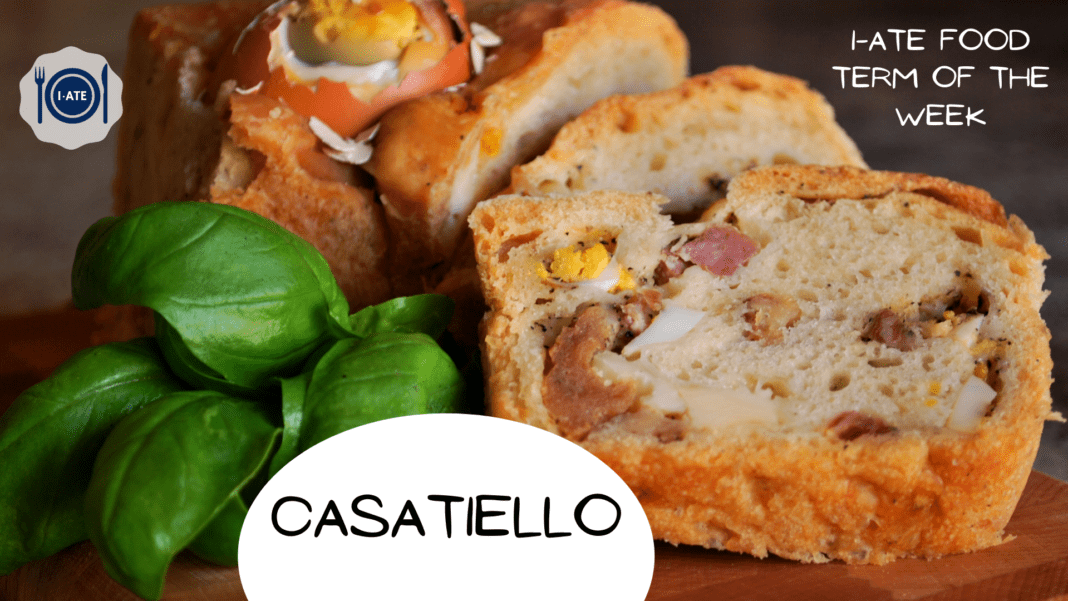With its crispy crust and its soft core, the Neapolitan casatiello is perfect to satisfy most tastes during the Easter period. The history of this Neapolitan Easter cake can be traced back to the Greek-Roman period, when spring festivals were organised in honour of the goddess Demeter (Ceres for the Romans). During these celebrations, known as Cerealia, they were used to making bread stuffed with various ingredients including eggs, which were considered the symbol of the reawakening of nature in spring. What later created a link between this pagan feast and Christianity is the resurrection of Christ (the Holy Easter), which falls right in the same period. This explains why the present-day Casatiello, with boiled eggs on the outside and whose shape resembles Christ’s crown of thorn, is viewed as the symbol of this holiday in the Campania region. Its appearance in Giambattista Basile’s “La gatta Cenerentola” in the XVI century further stresses its relevance to the Italian culinary tradition, and it is not without reason that its name comes from the Latin word caseus (cheese), caso in Neapolitan, as it is one of its fundamental ingredients. Moreover, the Neapolitan dialect features the expression “Sì ‘nu casatiello” [You are a Casatiello], which is metaphorically employed to describe an annoying and unpleasant person since Casatiello is not one of the lightest meals.
But which are its ingredients and how can they be put together to bake this salty doughnut? Its preparation can be divided into two stages: the dough and the filling. First, the dough is made by mixing flour, lard, grated Parmigiano and Pecorino cheeses, brewer’s yeast, water, salt and black pepper. While it rests for a couple of hours, the filling can be prepared by chopping and putting together cold cuts and cheeses such as: salami, cracklings, provolone, Emmenthal cheese, Pecorino cheese, Parmigiano cheese, and a generous sprinkling of black pepper. With the help of flour and lard, it is then necessary to mould the dough into different shapes. First, it must be made into a rectangular shape with the help of a rolling pin. After that, it is time to place the cold cuts and cheese mixture on top and roll it up into a cylindrical shape before placing it into a circular pan. The final touch is to place raw eggs on its surface and secure them with thin strips of dough perpendicularly placed to form a cross. Lastly, it is left to rest for another couple of hours and then it can be baked and served. As tradition has it, it is prepared since Holy Thursday and offered to family and friends.

Despite being one of its kind, the Neapolitan culinary tradition features a similar Easter cake known as Tortano. It is made with the same ingredients and has the same shape; what differentiate the two is where eggs are placed. While casatiello has eggs on top, tortano has egg slices on the inside. Therefore, the choice between casatiello and tortano during the Easter period is just a matter of family traditions rather than food preferences.
In addition to casatiello and tortano, other dishes characterise the Neapolitan Holy Easter. First, there is the sweet casatiello. Even though it is mostly just known in the Caserta area, it is not less tasty with its white icing and coloured sprinkles on top. Differently from the latter, pastiera is the most renowned Neapolitan Easter dessert. Tied to the myth of the Parthenope mermaid and viewed as a symbol of rebirth by Christianity, as it also contains eggs, it is prepared with shortcrust pastry, ricotta, eggs, wheat, orange blossom, sugar, and spices. Different varieties with fewer or more ingredients exist, and they are all worth the hype. All these and many other dishes are perfect to be prepared beforehand and consumed on Easter Monday, a day that is typically spent outdoor with family and friends in most southern Italian regions. Therefore, if you are going to pay a visit during the Easter period, be prepared to put on some weight with all those delightful dishes.
References:
Casatiello: storia ed etimologia del rustico pasquale [Online]. Available at : https://www.arpalieviti.it/blog/casatiello-storia#:~:text=Le%20croci%20sulle%20uova%20che,ne%20trova%20al%20suo%20interno. [Accessed 30th March 2022]
Il Casatiello perché si chiama così?. La gatta cenerentola e Basile… [Online]. Available at: https://napolipiu.com/casatiello-perche-si-chiama-cosi [Accessed 30th March 2022]
Casatiello – Neapolitan Easter Bread: history, recipe and secrets [Online]. Available at: https://enjoyfoodwine.com/casatiello-neapolitan-easter-bread-history-recipe-secrets/ [Accessed 30th March 2022]
Pastiera e Casatiello, how to celebrate Easter in a typical Neapolitan way [Online]. Available at: https://trueitalian.top/2021/04/04/pastiera-e-casatiello-how-to-celebrate-easter-in-a-typical-neapolitan-way/ [Accessed 30th March 2022]
Casatiello Napoletano – The Story Behind the Traditional Neapolitan Easter Recipe [Online]. Available at: https://www.nonnabox.com/casatiello/ [Accessed 30th March 2022]
Sapete perché si dice “Sì ‘nu casatiello cu l’uva passa”? [Online]. Available at: https://www.napolitoday.it/cultura/si-nu-castiello-cu-l-uva-passa.html#:~:text=Cio%C3%A8%20%E2%80%9Csei%20una%20persona%20greve,presenza%20dell’uva%20passita%22. [Accessed 16th April 2022]
Written by Raffaele Pizzo
PhD student in “Euro(pean) Languages and Specialised Terminology”, University of Naples “Parthenope”.

